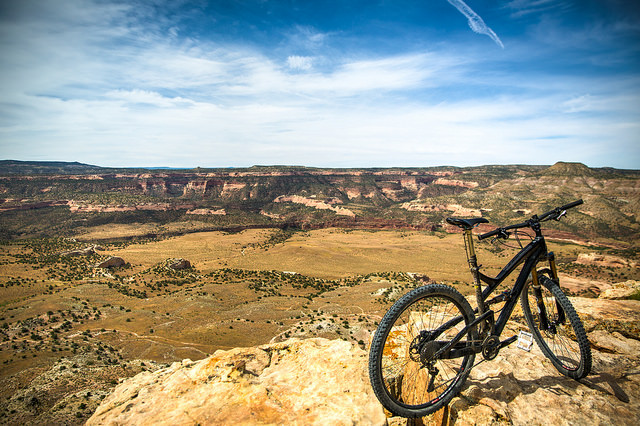Solo adventuring through the great outdoors can be thrilling and spontaneous while calming and peaceful. That is what makes independently trekking through the woods or a lone bike ride up and down a spiraling mountainside so appealing to many outdoors enthusiasts. The rush from the introspective struggle and harmony with nature when you are on your own is exciting, but it is also important to remember to be smart about your safety. Do not skip out on these simple preventative safety measures because when it is too late, it can really be too late.
But remember to have fun – there is no reason to be fearful as long as you think ahead! Here are a few tips to ensure your safety ahead of time, so you and your loved ones can embrace your adventurous spirit, worry-free, when you are on your solo adventures!
5 Outdoor Safety Tips for Solo Adventures:
1. Always tell at least two people exactly where you will be, and for how long, before you venture outdoors on your own.
For example, tell them the actual name of the trail you will be hiking, the name of the park, the body of water, etc. based on where you will be and your estimated times of arrival and return. It is good to notify at least two people instead of just one just in case one of them forgot the exact location you mentioned, mixed up dates, etc. The people you should inform are loved ones, such as a significant other, close friends and/or family or even a neighbor and/or roommate. If available, check-in at the information center or ranger station where you plan to be adventuring outdoors before you journey out on your own. Here at John Bailey Company, we enjoy the outdoors, so we developed a simple paper form called the Solo Safety Form that can be filled out before you head into the soothing wilderness for some me-time. If you live with someone, you can stick it on the fridge, on a memo/bulletin board, tape it near the computer desk, or you can fill it out and give it to your friend or neighbor if you live alone – the Solo Safety Form is just one more safety measure you can take to feel happy and responsible about your alone-time away from home.
2. Keep a physical map of your excursion’s territory on hand at all times, and make sure it is a current map of that trail or area.
In case your GPS fails you (which is likely when you are in the deep woods, out on the water, etc.), you want to know where you are and be able to get to safety if you are troubled or in serious danger.
3. Account for the weather and climate conditions in the area you will be exploring for the span of time you plan on spending there.
Take note of any recent storms, or even fires, as they can affect the landscape – be prepared with whatever gear you need for the current state of the terrain accordingly. In fact, harsh enough conditions may cause you to have to reschedule for optimal safety. If you are looking for a good weather application, try Accuweather.
4. Always have water.
No matter what, always carry enough water for the amount of time you are estimating you will be away from easily accessible drinking water. Dehydration is the last thing you want to be battling in the wilderness alone – it can affect logical thinking within cognitive functions and can also physically cause you to faint – both cases make it difficult to reach safety.
5. Take advantage of fellow outdoors enthusiasts’ input and innovations.
You are not the first outdoorsman/outdoorswoman, and you will not be the last, so it is only natural that we can learn a thing or two from each other’s experiences. We all share ideas when they prove to be effective – a couple of great wilderness-inspired resources available for outdoors enthusiasts are the Road ID bracelet and the Find My Friends app (or any other free Android-compatible version of this app).
An excellent way to ensure your safety in the event of an unfortunate event while exploring the outdoors alone is with a Road ID bracelet. It is a durable wristband with a small, customizable metal plate engraved with your name and any additional information you choose. In the event of an emergency, if you are found and in need of outside help, your body can be identified if you are not in a condition to be able to speak for yourself when help is near. Check out the bracelets and numerous testimonials of how the Road ID bracelet has saved the lives of several outdoors enthusiasts’ at roadid.com!
Check out the Find My Friends app, which is available for iPhone users only, however, there are comparable (and compatible) Android versions available as well. If you are group-adventuring, find something that works for everyone in your group, or at least one member of each smaller group (should you choose to break into smaller groups or individually spend some time alone).
(For extra protection, several experienced outdoorsmen and outdoorswomen suggest that when you are planning your own solo outdoors adventures, you may want to equip yourself with pepper spray, a knife, a small hatchet or even a registered and regionally/park-approved firearm to protect you from any physical dangers you could face while you are in the wilderness alone.)
Is an itinerary worth your life? You decide: Always tell somebody what trail you are taking and how long you expect to be there. Pack a physical map of the area, account for weather and current climate conditions before your trip and pack enough water. And do not forget – check into Road ID bracelets and the Find My Friends app for simple and preventative life-saving safety measures for exploring the outdoors!
Do not be afraid to venture out solo – be smart, stay inspired and have fun! Depending on how we are feeling, sometimes we journey through our minds and worlds without communicating others. And then the unexpected happens. Seasoned outdoorsmen, Aron Ralston is a well-known rock climber whose story is every bit as inspiring as it is frightening. But his resilience to giving up is admirable and uplifting. Check out his story – both his book (a captivating autobiography), “Between a Rock and a Hard Place” and the film that was written thereafter based on Ralston’s rock climbing accident, “127 Hours” (directed by Danny Boyle and starring James Franco), which won an Academy Award for Best Motion Picture of the Year in 2010. In this film, we see that while communication is important, life happens – we are all affected differently – but regardless, things do not always go as planned. Just remember, no matter what: Do not ever give up on yourself because you never know what the outcome would have been if you did not at least try! Both Ralston’s book and the cinematic production of that experience intensely portray mind over matter – his true story is a testament to the willpower of man.
Photo: Zach Dischner

